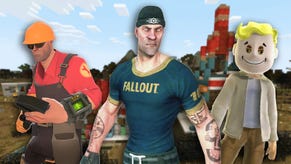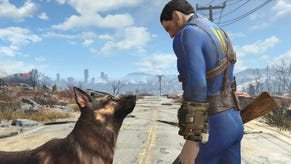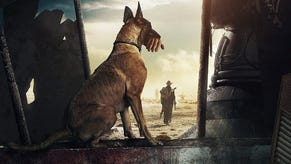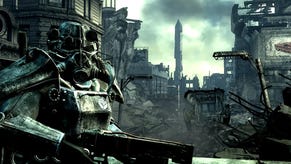The Fallout 3 we never got to play
Here's A Thing.
In October of 2008, Bethesda Game Studios released Fallout 3 and in doing so, changed the series forever. Gone were the 2D sprites, isometric camera and turn-based combat of the original games in favour of something the studio believed could appeal better to a larger, more mainstream audience. And well, the nearly five million units shipped during the game's launch week suggest they were probably right on that front, but still, there remains a substantial number of fans that to this day lament the loss of classic Fallout.
Which is why in today's Here's A Thing we're going to take a look back at the Fallout 3 we never got to play. Often referred to as the Van Buren project, named for the eighth President of the United States, this game was in development at Black Isle Studios during the early 2000s, but was eventually canceled due to financial difficulties within Black Isle's parent company, Interplay Entertainment.
I'd like to extend a huge thank you to the game's two lead designers, Chris Avellone and Josh Sawyer for talking me through their work, in detail, all these years later. Avellone, in particular, was able to send me a bunch of early design notes which we'll be showcasing here.

So yes, that's where we'll start, with Chris Avellone. He'd previously been a designer on Fallout 2 before going on to lead development on Planescape: Torment and then work on Icewind Dale 1 & 2, as well as Baldur's Gate: Dark Alliance.
All of that in the space of four or five years, by the way. Yeah, he really doesn't mess around.
In fact, he was even busier than that. Because in between work on those massive RPGs, Avellone was also plotting another project. He was getting ready to return to the wasteland.
Although Interplay didn't have the resources to commit to a new Fallout game just yet, at some point later down the line, he was told, it would. And so eager to be ready for that moment, Avellone began to work on its design.
But as a solo effort, there was only so much he could do. How was he meant to properly prototype a game without a team to work with? He couldn't.
And so he did what only an RPG designer could in that scenario. He set up an out-of-hours pen & paper game and recruited people from the studio to play through his vision for Fallout 3, but as a tabletop experience.
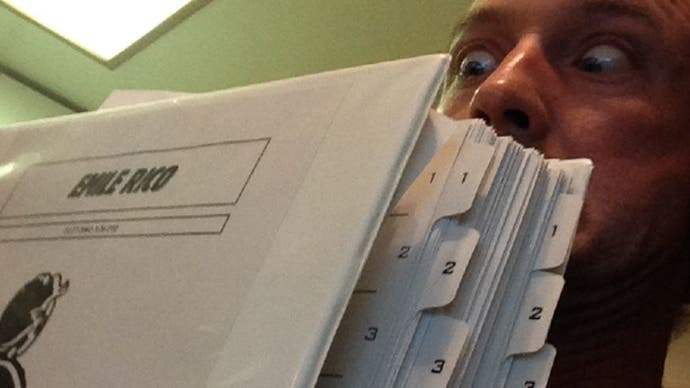
This isn't unique to Avellone, I'm told. James Ohlen, the Creative Director for Baldur's Gate is said to have taken plenty of inspiration from his D&D campaigns for some of the companion characters used in that series.
I asked Avellone how much of the design for Fallout 3 was rooted in this pen & paper game he was running.
"Oh just about everything," said Avellone. "For each area, I'd write a module about it, including the art design documentation, reference art for the characters, reference arts for the key vistas and locations. So basically, every section of the pen & paper game the players went through ended up becoming an area design document."
If you like that anecdote, you're about to like it a whole lot more. You see, he wasn't running just a single game. No, he needed more playtesting than that. There were actually two separate games running simultaneously. And it turned out these two sessions weren't actually all that separate. Unbeknownst to the players, at least, to begin with, the two parties existed in the same universe and their actions would be referenced, albeit subtly at first, in each other's play sessions.
This tied into Avellone's narrative plan for Fallout 3 which was going to feature an antagonist leading a rival party who the player would then run into throughout the course of the game.
And on a practical level, having this many players involved in the game meant they were bringing lots of different character archetypes into his world. Avellone would then need to accommodate for their different playstyles when designing quests and different locations.
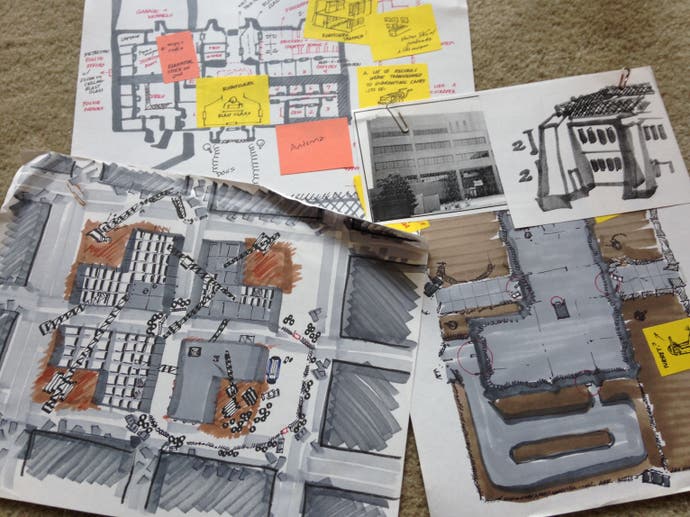
Although Fallout doesn't rely on distinct classes like many RPGs, Avellone recognised that players still tended to approach situations in one of three ways: relying on either combat, stealth or the speech skill. It was that last approach he felt could use some work in particular.
"The one thing that's always kind of bothered me about Fallout," said Avellone. "Is that there's been a trend, and this is going to sound really specific, of using the speech skill as an instawin. I see the speech skill, so I'm not even going to think about it, I'm just going to choose it because that's going to allow me to get the optimum result from this conversation.
"What I prefer is the mechanics we were going to do for Van Buren. We were going to give you more information about the person you were talking to, the longer you talked about them. Then you'd get to choose dialogue options that manipulate them a certain way. So for example, it may not be a bad thing to make someone hostile because you know based on speaking with this person, getting a sense of their psychology, what they're going to do when they get mad. That might be to your advantage. So seeing the red hostile response may not be a bad thing and a Speech character may want to guide a character towards that and provoke a certain result."
There was other types of playstyle he wanted to accommodate for, on top of this. Inspired by a book called Lucifer's Hammer in which a character manages to take advantage of some advanced scientific knowledge that had been preserved from a time before the apocalypse, Avellone thought it might be fun to explore the idea of how a scientist with access to equipment and knowledge that pre-dated the nuclear war might be able to thrive in the wasteland.
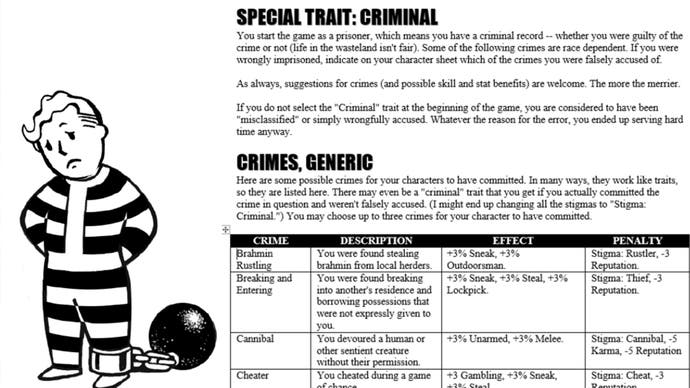
He designed a number of locations and questlines that catered for this kind of character type, including the Boulder Science Dome, a huge research facility that was also home to a community of scientists that had put themselves into a cold sleep stasis before the nukes were dropped.
The first of these scientists to wake, a genius by the name of Presper would be the party leader antagonist we mentioned earlier. In Avellone's initial outline for the game's story, Presper monitored the player's actions throughout the game and then decided whether or not to cleanse the entire world of human life before waking his fellow scientists based on your decisions. No pressure.
The player themselves was known as The Prisoner, as you'd begin the game escaping what you believe to be a prison in the American Southwest. Interestingly, during the character creation stage, you can decide whether or not your character was rightly convicted. If you decided that you had, in fact, been a criminal you could then select which crime you'd committed: were you a brahmin rustler? A chem user? Or a cannibal? Depending on your selection this would then impact your starting stats.
Oh here's another thing you could select too: your character's race. The Fallout 3 we never played would have given us the option to play as either a human, a ghoul or a super mutant.
"Yeah and each of them had their own communities and specific quests over the course of the game," explained Avellone. "Their own special traits, perks, and limitations that they could choose. Yeah, the fact that you could play something beyond a human was definitely one of the goals of the game."
He also had plans to reinvent the Pip-Boy in Fallout 3, allowing players to monitor the Pip-Boys worn by the other prisoners that escaped alongside you, meaning you could then do things like reading their quest logs to see where they are and what they're up to.
And more than that, your Pip-Boy would become useful in different kinds of situations as you played through the game.

"You'd start getting mods and add-ons and discovering new functionality if you're placed in dangerous situations," said Avellone. "Like, if you're trapped in a building and a fire broke out - this is a really small example - your Pip-Boy would suddenly wake up, let you know where all the fire exits were and where the sprinkler system was. And then suddenly you could use that functionality in any building you went into.
"So the more you explored and the more you got exposed to certain situations, the more your interface would grow and expand. We sort of wanted the interface to feel like another dungeon you were exploring over the course of the game."
Now Chris Avellone actually resigned from his position at Black Isle Studios before Fallout 3 was canceled, as he went to co-found Obsidian Entertainment.
Josh Sawyer steps in as the new lead designer and by now there's a full team in place who had been using Avellone's pen & paper design documentation as a starting point for their work.
Sawyer, it's worth knowing, had previously been the lead on another canceled project called The Black Hound, which had eventually become Baldur's Gate III: The Black Hound despite Sawyer's protests that his story had very little to do with that series.
Anyway, the advantage of coming off that project is that Sawyer and the team now had access to a new 3D Game Engine. In fact, if you've seen the leaked Van Buren tech demo from 2007, this is meant to be a reasonably accurate reflection of what the game looked like by the time it too was canceled come the end of 2003.
"I think time has made the public more aware that the development process is pretty clumsy and clunky at times and that stuff doesn't look good until the very end. But actually, I will say the Van Buren leaked demo is about as good as the game ever looked."
When I spoke to him Sawyer was eager to point out that although the series was making its jump to 3D graphics, it was important to the team that it still felt like Fallout. This meant small touches, like for example, when you entered a building it wouldn't load a brand new level, but rather have the roof become transparent as in Fallout 1 & 2.
The shift from 2D sprites to 3D character models also meant features like a piecemeal armour system could be introduced, The player could equip different bits and pieces of gear and this was then properly displayed in-game. The power armour, I'm told, was a bit of a nightmare to get right.
Interestingly, Sawyer cited games retailers as the driving force behind two of the game's design decisions. First up, there was pressure to drop the turn-based combat entirely and replace it with a real-time system, thanks to the success of games like the Diablo franchise.
"That really disappointed me," said Sawyer. "Because I really wanted to make a turn-based game. I still want to make a turn-based game after all this time. So I said: Tactics had a turn-based game and real-time with puase, so could we have something like that? And in my mind, I was just going to focus almost all of my effort on making sure the turn-based combat felt as good as it could."
And they also wanted the game to have a multiplayer element too.
"At that point in time, there was much more pressure - again from retailers - to have co-op multiplayer in everything. I always thought it was a big waste of time because I knew the actual stats of people who played. Even in the Infinity Engine games, you'll find people that say I love playing co-op multiplayer! You're one in a million people. Most people didn't really play it for very long and it was huge amount of work."
By the time the tech demo you're watching was created, Sawyer said the game was realistically more than a year away from completion. Unfortunately, it never made it to that point as Interplay faced major financial struggles and laid off the entire staff of Black Isle Studios on the 8th December, 2003.
Now this is the second time we've properly delved into a canceled game on Here's A Thing after looking at Human Head's Prey 2 earlier this year. But this story does have a slightly different ending. One that's perhaps more uplifting.
Because if you've played 2010's Fallout: New Vegas, the Fallout game published once again by Bethesda, but developed this time by Obsidian Entertainment with Josh Sawyer as the game director and Chris Avellone as a writer and director for the DLC, then you will have experienced to some extent the legacy of this Fallout 3 that never was.
Set once again in the American Southwest, there's a whole host of ideas and locations big and small that made their way into New Vegas. The Hoover Dam was pulled straight out of Avellone's pen & paper game, although back then it was actually more of a community rather than something to be fought over.
The The Big Mountain Research and Development Center from Old World Blues? That's largely based on the Boulder Dome.
Caesar's Legion, the Burned Man, they were there although envisioned somewhat differently.
And that whole side quest with the Nightkin suffering psychological damage because of their Stealth Boys? Yeah that's from the pen & paper session too, as was Elijah, the primary antagonist of Dead Money, although he'd originally been a companion.
Speaking of companions, here's an especially cool one. Josh Sawyer was one of the players in Avellone's tabletop campaigns, in fact, he played two different characters. They would become Arcade Gannon and Jean-Baptiste Cutting.
Maybe I should have renamed this piece, now that I think about it. This is the story of the Fallout 3 we never played, but then, sort of did, years later. That's not quite as catchy, but it does a better job of describing what happened here. And that's a great thought. Game cancellations can be incredibly rough. Pulling a project often has massive implications on people's lives and sometimes result in years worth of work vanishing overnight. It's cool to hear that in this case, at least, the ideas lived on. The game may never have hit shelves, but part of the vision behind it did.
Also Fallout: New Vegas is fantastic. So, there's that too.





